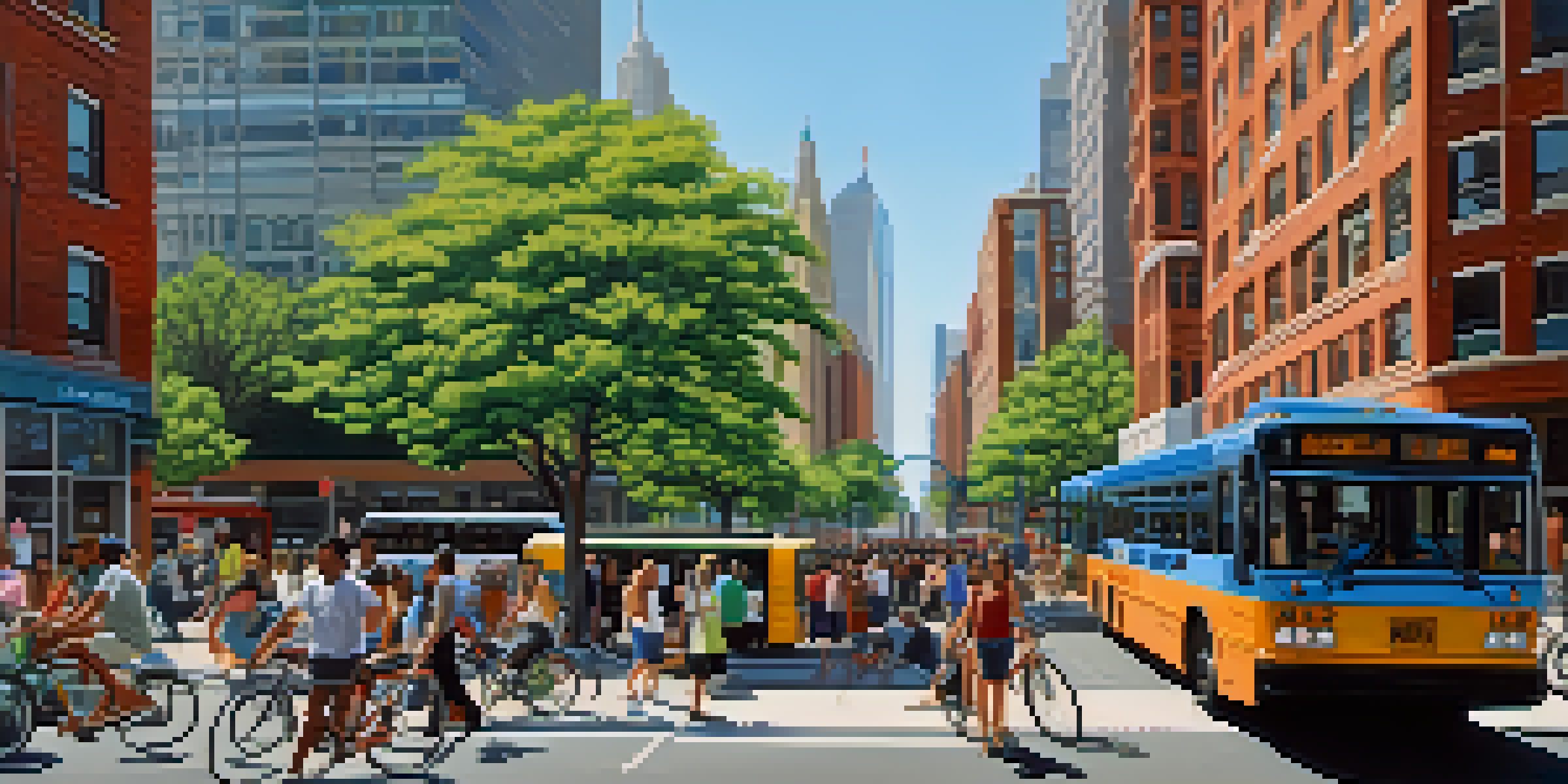Evaluating the Environmental Impact of Jersey City Transit Options

Understanding Jersey City’s Transit Landscape
Jersey City boasts a diverse array of transit options, including buses, light rail, and ferries. Each of these modes contributes uniquely to the city’s overall transportation ecosystem. As residents and visitors navigate the city, understanding these options is crucial for informed travel choices.
The greatest threat to our planet is the belief that someone else will save it.
The city’s transit network not only connects various neighborhoods but also plays a significant role in shaping its environmental footprint. With the growing emphasis on sustainability, evaluating these transit options becomes essential to understanding their impact on air quality and energy consumption.
By examining the current state of transit in Jersey City, we can better appreciate how each option contributes to reducing or exacerbating the city's environmental challenges. This foundational knowledge sets the stage for a deeper exploration of their individual impacts.
The Role of Public Buses in Sustainability
Public buses are a cornerstone of Jersey City's transit system. They provide an affordable and accessible means of transportation for thousands of commuters daily. When considering their environmental impact, it's essential to note that buses can reduce the number of cars on the road, leading to lower greenhouse gas emissions.

However, the efficiency of buses varies based on factors such as route density and ridership. High ridership on well-planned routes can significantly decrease per-passenger emissions, making buses a more sustainable choice. Conversely, underutilized routes may lead to inefficiencies that detract from their environmental benefits.
Diverse Transit Options in Jersey City
Jersey City's transit network includes buses, light rail, and ferries, each contributing to sustainable travel and reducing environmental impact.
Investments in cleaner, electric buses are also transforming this sector, further improving their sustainability profile. By focusing on enhancing bus networks and adopting greener technologies, Jersey City can bolster its commitment to reducing environmental impact.
Light Rail: An Eco-Friendly Transit Solution
The Jersey City Light Rail offers a unique and eco-friendly transit option, operating on electricity rather than fossil fuels. This shift not only minimizes air pollution but also reduces reliance on non-renewable energy sources. It stands as a greener alternative compared to traditional gas-powered vehicles.
Sustainability is not a goal to be reached, but a way of thinking and living.
Moreover, light rail systems typically have a higher passenger capacity than buses, which can lead to even greater reductions in per-passenger emissions. This capacity becomes particularly beneficial during peak travel times when congestion is at its highest.
As the city continues to invest in expanding and upgrading the light rail network, its potential to serve as a sustainable transit solution grows. By promoting increased ridership through improved service and accessibility, Jersey City can further capitalize on this eco-friendly option.
Ferries: Connecting the Waterways Sustainably
Ferries are a scenic and efficient way to travel in and around Jersey City, connecting residents to Manhattan and other waterfront areas. Operating on water, these vessels offer a unique transit experience while also presenting an opportunity for reduced road congestion. However, their environmental impact is multi-faceted and merits careful consideration.
While ferries can help alleviate traffic, they are often powered by diesel engines, which can lead to air and water pollution. Nevertheless, advancements in ferry technology, such as electric or hybrid models, show promise for improving their sustainability. As the demand for cleaner alternatives grows, it's crucial for ferry operators to embrace these innovations.
Sustainable Benefits of Buses and Rail
Investments in electric buses and light rail enhance sustainability by lowering emissions and accommodating more passengers efficiently.
Enhancing ferry services could also encourage more people to choose this mode of transit, further promoting its environmental benefits. By prioritizing greener technologies, Jersey City can position ferries as a viable and sustainable transit option for the future.
Walking and Biking: The Most Sustainable Options
Walking and biking are undoubtedly the most environmentally friendly ways to navigate Jersey City. Not only do they produce zero emissions, but they also promote healthier lifestyles for residents. As the city invests in pedestrian-friendly infrastructure and bike lanes, these options are becoming increasingly viable for daily commutes.
Creating safe, accessible spaces for pedestrians and cyclists encourages more people to leave their cars at home. This shift can lead to a significant reduction in traffic congestion and pollution, further benefiting the environment. Programs that promote bike-sharing and walking events can also enhance community engagement.
By prioritizing walkability and cycling, Jersey City can foster a culture that values sustainable transportation. This not only improves air quality but also contributes to a more vibrant urban environment where residents can thrive.
The Impact of Ridesharing Services
Ridesharing services like Uber and Lyft have transformed how people travel in Jersey City. While they provide convenience, their environmental impact is complex. On one hand, they can reduce the need for personal vehicle ownership and potentially decrease the total number of cars on the road.
On the other hand, ridesharing can lead to increased traffic and emissions if not managed properly. Studies suggest that ridesharing services might encourage more people to opt for solo rides rather than sharing, thus negating some of their environmental benefits. Understanding these dynamics is crucial for evaluating their overall impact.
Walking and Biking for Healthier Living
Promoting walking and biking as primary transit options encourages healthier lifestyles while significantly reducing carbon footprints.
As Jersey City continues to evolve its transportation landscape, integrating ridesharing with public transit could enhance sustainability. By promoting shared rides and incentivizing carpooling, the city can harness the benefits of these services while minimizing their environmental footprint.
Evaluating the Carbon Footprint of Each Option
Understanding the carbon footprint of various transit options is key to making informed decisions. Public transportation generally boasts a lower carbon footprint per passenger compared to personal vehicles. However, the actual environmental impact depends on factors like vehicle efficiency, energy sources, and ridership levels.
When evaluating options like buses, light rail, ferries, and ridesharing, it's essential to consider their emissions relative to the number of passengers they serve. For instance, a full bus can significantly reduce individual emissions compared to a single-occupancy vehicle. This evaluation can help identify the most sustainable choices for commuters.

By promoting transparency in carbon emissions data, Jersey City can empower residents to make greener travel choices. Such evaluations not only enhance awareness but also encourage the city to invest in the most effective transit solutions for a sustainable future.
Future Directions for Sustainable Transit in Jersey City
Looking ahead, Jersey City has an exciting opportunity to enhance its transit options through sustainability initiatives. By investing in electric buses, expanding bike lanes, and improving public transportation accessibility, the city can lead the way in eco-friendly transit solutions. Community engagement will also be vital in shaping these initiatives.
Collaboration between city planners, transit authorities, and residents can drive innovative solutions that meet the needs of all users. Additionally, incorporating technology to monitor and optimize transit efficiency will further reduce environmental impact. As awareness of climate change rises, cities must adapt to changing transportation demands.
By prioritizing sustainable transit options, Jersey City can not only improve its environmental footprint but also elevate the quality of life for its residents. Emphasizing accessibility and eco-friendliness will ensure a healthier, more vibrant community for generations to come.